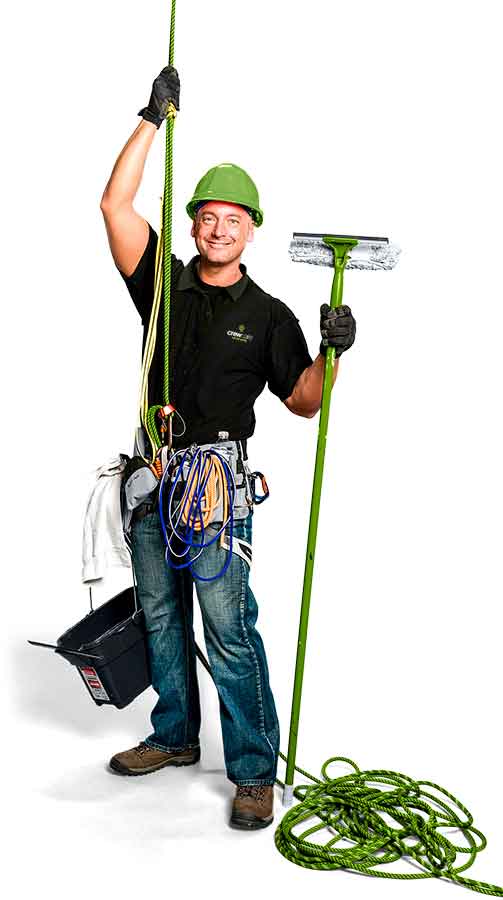Professional window cleaning is a busy industry. The demand for glass buildings and the requirement of more natural lighting has been increasing the demand for these services. As more high-rise residential and commercial buildings are constructed, the need to develop safer and more effective technologies for cleaning exterior windows at heights has been evident.
There have been big steps forward in window cleaning technologies over the last decade. Most of these have been focussed around pole, rope and cradle systems – but more recently window cleaning robots are being introduced. Yes, you read that right – robots!
In this update we take a look at the various methods for cleaning windows at heights, so read on to find out more about flying robot window cleaners!
Telescopic poles
Telescopic poles have been a standard piece of cleaning gear for several decades. While they are very effective for window cleaning, they are limited in their range. Most telescopic poles are only effective to 6 or 7 metres high. When you are cleaning a large multi-storey building, this isn’t the most effective approach. You also need to be able to operate a washer and squeegee at these heights, which can be difficult for even the most experienced cleaners.
Water fed poles
Telescopic poles have been improved over the years with the invention of the water fed pole. This combines brush, water, and pole all in one, which has significantly improved the ease and efficiency of cleaning windows at heights. These have been further enhanced with the introduction of high-tech carbon fibre, and the utilisation of purified water to clean the glass.
Carbon fibre is lightweight and incredibly strong. It is made of very thin strands of carbon and is five times stronger than steel per unit of weight. It is highly resistant to chemicals and has a tolerance for high temperatures. This makes carbon fibre tools great for the demanding nature of professional window cleaning.
Using purified water ensures that windows will dry completely clean. Tap water contains various minerals and salts and if it is left to dry on glass, it leaves water spots and residue behind. Purified water also reduces the reliance on chemicals to produce streak-free results – which is an added bonus for the environment!

Abseiling
Window cleaners dangling from an abseil rig is probably a familiar sight to anyone who works in a high-rise building. Using rope access to get to higher up windows gives cleaners direct access to the glass, as opposed to using water-fed poles from further away. They can get up close to provide a thorough and professional clean. They can also manoeuvre around easier and get the hard to reach places that poles might miss.
Abseil or rope access does come with its fair share of risks and health and safety regulations – for obvious reasons! There may also be privacy considerations for clients in sensitive industries or government organisations. They may not want to risk people hanging out outside their windows and potentially seeing confidential information on computer screens.
Cradles and platforms
In some buildings, the only way to reach the windows will be to suspend a cradle over the side of the building. Modern buildings will sometimes be fitted with integrated cradle systems to make this easier and safer. Others require a specialist set up, where the building height, size of the windows, and strength of the building all need to be taken into account.
When a cradle system is not suitable or not available, mounted platforms can be another option. This is when adjustable hydraulic platforms, often mounted to a truck or other large vehicle, are used to access the higher windows. They are easily controlled and manoeuvred and come with safety rigs and guardrails, just like a suspended cradle.
Window cleaning robots and drones
Now to the really cool part – the robots! Water spraying drones are the coolest piece of technology to hit the commercial window cleaning industry. The drones are water fed from a (very long) hose that remains connected to the ground. The drone can then fly up to the façade of tall buildings and wash and squeegee windows at any height.
Not only are these window cleaning robots faster than their human counterparts, but they also do an amazing job in taking away a lot of the health and safety concerns of people working at these extreme heights. The window washing crew can stay safely on the ground and manage the hose and drone controls, while the drone goes up and takes care of everything else. This significantly reduces the risk of injury or fatalities.
These water fed drones have other possible uses too – such as putting out fires on higher building levels.
The professional window cleaning industry is always looking for ways to innovate and improve its technology and tools. These new window cleaning technologies have meant that safety concerns are reduced, and efficiency and profitability are increased. And not to mention – impeccably clean windows!


